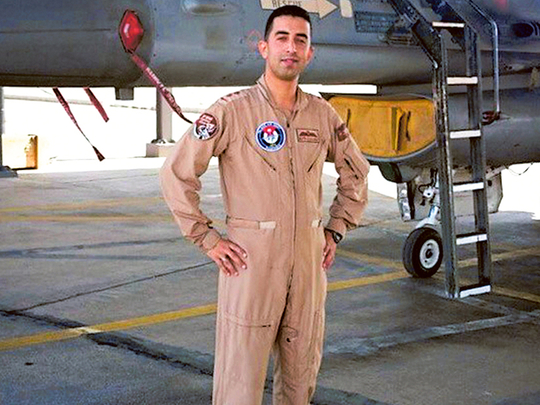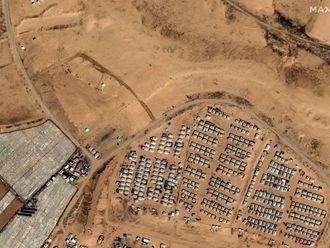
Beirut: The gruesome death of a captive Jordanian pilot, burnt alive in a cage in a grisly spectacle posted on the internet, drew global revulsion on Tuesday as the Jordanian government braced for possible unrest and vowed prompt retaliation against his Daesh killers.
Jordanian state television confirmed the death of Lt Muath Al Kaseasbeh, 26, saying he had been “martyred” a month ago. If true, that would mean a recent push for his release in a prisoner swap had been in vain.
“The blood of the martyr hero will not go to waste,” declared an army statement read on Jordanian state TV. “It will be vengeance equal to the tragedy of all the Jordanians.”
The hostage drama had transformed the pilot into a national hero in Jordan, where images of him, often wearing a blue military beret, have become ubiquitous on television, newspapers and posters.
His ghastly killing plunged an irate nation into profound mourning amid fears that mass protests could erupt, either demanding retaliation or questioning the kingdom’s involvement in the US-led offensive against Daesh.
By its actions, analysts said, the militant group appeared determined to convince supporters and potential recruits that it remains ruthless, undaunted and committed to its radical vision of an “Islamic caliphate,” despite a string of recent battlefield reversals in Syria and Iraq.
But many say it is a strategy that could backfire in its wanton brutality.
“While [Daesh] has managed to manufacture a domestic crisis for Jordan, its barbaric killing of the Jordanian pilot will most likely turn Jordanian public opinion and broader Muslim opinion against [Daesh],” predicted Fawaz Gerges, a Middle East scholar at the London School of Economics.
‘Catastrophic miscalculation’
“I would argue that this is a catastrophic miscalculation on the part of [Daesh],” Gerges added in an interview. “I have no doubt in my mind that this will represent a tipping point in the Muslim world.”
Many analysts have said the militants’ aim was to sow dissension in Jordan, which is both a staunch US ally and home to many militant Islamists deeply opposed to Washington’s policies in the region.
The video was released, perhaps deliberately, as King Abdullah II, a steadfast ally on counterterrorism efforts, was on a state visit to Washington. He later met privately with President Barack Obama at the White House. As the meeting got under way, an adviser to the president said Obama planned to reassure Abdullah of the US commitment to fighting the militant group.
Earlier, Obama condemned the “viciousness and barbarity” of the killing and vowed that the US-led coalition would redouble its efforts to make sure that Daesh is “degraded and ultimately defeated.”
But US officials were vague later when asked whether the president’s comments indicated any escalation of the US-led campaign, which has already resulted in more than 2,000 air strikes against Daesh positions in Iraq and Syria. Both nations share long borders with Jordan.
There were unconfirmed reports that Jordan would hasten the execution of a jailed militant, Sajida Al Rishawi, a failed Iraqi suicide bomber on death row in Jordan for her role in a series of bloody attacks on Amman hotels in 2005. She was an operative of Al Qaida in Iraq, a predecessor of Daesh, which has been demanding her release.
The pilot had been in the extremists’ hands since December 24, when his F-16 jet crashed in Syria while on a mission with the US-led coalition.
Many observers had assumed that the pilot, a valuable asset for the hostage-takers, would be used in a bid to swap multiple prisoners and extract other concessions from Jordan, perhaps even as a wedge to push Amman out of the coalition.
Instead, Daesh opted to stage the slaying of a fellow Muslim as its latest and most shocking propaganda vehicle, this one even more disturbing than the group’s now-infamous videos featuring the beheadings of hostages, including two US journalists and an American aid worker.
The pilot is from a prominent tribe in the southern city of Karak that, like Daesh, is Sunni. Tribal members, important backers of the Jordanian state, had pressured officials to do everything possible to win the release of the pilot. Some had publicly criticised the kingdom’s role in the bombing campaign.
Late Tuesday, Jordanian media reported that the distraught family pushed away photographers who had gathered outside the tribal meeting hall as the pilot’s father, Safi Kaseasbeh made his way out of the building.
The government urged a united response.
In a recorded speech to his nation, King Abdullah urged Jordanians to “stand as one rank and show the mettle of the Jordanian people in facing the hardships and tragedies that will only strengthen our power and unity.”
Speaking on state TV, government spokesman Mohammad Momani seemed to be addressing those who criticised Jordan’s participation with Washington.
For Jordanians “who doubted the savagery of Daesh, this is the proof,” the spokesman said. “He who thought they represented true Islam, then this is the proof.”
Momani predicted the brutal killing would bring Jordanians together “in the face of this evil.”
“Those who doubted the unity of the Jordanians in the face of this evil, we will show them the proof,” said the government spokesman. “He who doubted that Jordan’s response will be decisive and shaking and strong, the proof will come to them, and they will know that the anger of the Jordanians will shake their ranks.”
The militants’ 23-minute video released on Tuesday included a rambling screed against Jordan’s participation in the “crusader” coalition.
As has become routine in Daesh videos, the recording showed the doomed man issuing a statement under duress that blamed his government for his death.
The pilot said Jordan had “a traitor Zionist” government, and questioned why it didn’t send its forces against “the Jews, who are closer to us.” Jordan is one of the few Arab nations that recognise Israel.
He appealed to the families of other pilots to “stop your sons ... so that what happened to me does not happen to your sons, and your families are not saddened like mine.”
The video builds up to the immolation of Al Kaseasbeh, who is seen in a cage in the midst of a shattered, bombed-out landscape. His left eye is blackened. His orange jumpsuit appears to be wet, probably doused with gasoline or another accelerant.
Nearby, militants in identical fatigues and beige balaclavas, all holding AK-47 rifles, stare ominously from the remains of a smashed building.
A single militant holds a torch, which is lighted by a comrade and then placed on a line of fuel that leads to the cage. The strip of fire quickly races forward and engulfs the makeshift death house. The prisoner flails about helplessly as the raging inferno consumes him.
Until Tuesday, there had been some hope that a deal could be reached to free the pilot. The Jordanian government was reported to have been negotiating with Daesh through intermediaries.
Jordanian authorities had offered a prisoner swap in which Al Kaseasbeh would be freed in exchange for Al Rishawi, the failed suicide bomber.
But in its public comments, Daesh said only that it would delay the pilot’s execution and release a captive Japanese journalist, Kenji Goto, in exchange for Al Rishawi.
The fates of the Japanese journalist and Jordanian pilot soon became entwined in a wrenching drama that resonated deeply in their homelands, both US allies on opposite sides of the planet.
Jordan said it would not proceed with any deal unless it received proof that the pilot was alive. That proof never came. It was unclear when the government learnt that he had been killed on January 3.
On Saturday, Goto was reportedly beheaded by Daesh. His killing came a week after the reported beheading of another Japanese hostage, Haruna Yukawa.












